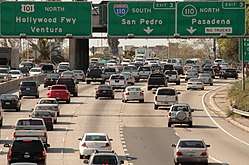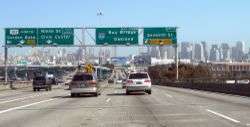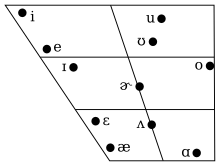California English
California English (or Californian English) collectively refers to varieties of American English native to California. A distinctive vowel shift was only first noted by linguists in the 1980s in Southern California and the San Francisco Bay Area of Northern California,[1] helping to define an accent emerging primarily among youthful, white, urban, coastal speakers.[2][3] Since that time, California speech has been mostly associated in American popular culture with adolescent and young-adult speakers of coastal California; the possibility that this is, in fact, an age-specific variety of English is one hypothesis.[4] Other documented California English includes a "country" accent associated with rural and inland white Californians, an older accent once spoken by Irish Americans in San Francisco, and distinctly Californian varieties of Chicano English associated with Mexican Americans. Research has shown that Californians themselves perceive a linguistic boundary between Northern and Southern California.[5]
| California English | |
|---|---|
| Region | California |
Indo-European
| |
| Language codes | |
| ISO 639-3 | – |
| Glottolog | None |
Linguists who studied English as spoken in California before and in the period immediately after World War II tended to find few, if any, patterns unique to the region.[6][3] However, as California became the most diverse U.S. state, English speakers from a wide variety of backgrounds began to pick up different linguistic elements from one another and also develop new ones as a group.[7] Today, most California English still basically aligns to General American English, specifically falling under a Western American accent.
Urban coastal variety
The variety of English most popularly associated with California has been most correlated by linguistics research with speakers in the major urban areas along the coast. The following vowel diagram represents the relative positions of the stressed pure vowels of the accent, based on nine speakers from southern California in the 1990s.[8] Notable is the absence of /ɔ/ (the vowel sound of caught, stalk, clawed, etc.), which has completely merged with /ɑ/ (the vowel sound of cot, stock, clod, etc.), as in most of the Western United States, as well as the relatively open quality of /ɪ/ due to the California vowel shift discussed below.
| Front | Central | Back | ||||
|---|---|---|---|---|---|---|
| lax | tense | lax | tense | lax | tense | |
| Close | i | u | ||||
| Close-mid | ɪ | e | ə | ʊ | o | |
| Open-mid | ɛ | ʌ | ||||
| Open | æ | ɑ | ||||
| Diphthongs | aɪ ɔɪ aʊ | |||||
A few phonological processes have been identified as being particular to California English. However, these vowel changes are by no means universal in Californian speech, and any single Californian's speech may only have some or none of the changes identified below. These sounds might also be found in the speech of some people from areas outside of California.
- Front vowels are raised before /ŋ/, so that the traditional "short a" /æ/ and "short i" /ɪ/ sounds are raised to the "long a" [e] and "long ee" [i] sounds, respectively, when before the ng sound /ŋ/. In other contexts, /ɪ/ (as in bit, rich, quick, etc.) has a fairly open pronunciation, as indicated in the vowel chart here. Similarly, a word like rang will often have the same vowel as rain in California English, rather than the same vowel as ran.
- Before /n/ or /m/ (as in ran or ram), /æ/ is raised and diphthongized to [eə] or [ɪə] (a widespread shift throughout most American English). Elsewhere, /æ/ is slightly lowered in the direction of [a] (something like the open a sound in Spanish or Italian), as a result of the California vowel shift (see below).
- Most California speakers do not distinguish between /ɔ/ and /ɑ/ (the vowel sounds in caught versus cot), characteristic of the cot–caught merger.[9]
- The rise of uptalk[10] in Southern Californian English.
California vowel shift

One topic that has begun to receive much attention from scholars in recent decades has been the emergence of a vowel-based chain shift in California. This image on the right illustrates the California vowel shift. The vowel space of the image is a cross-section (as if looking at the interior of a mouth from a side profile perspective); it is a rough approximation of the space in a human mouth where the tongue is located in articulating certain vowel sounds (the left is the front of the mouth closer to the teeth, the right side of the chart being the back of the mouth). As with other vowel shifts, several vowels may be seen moving in a chain shift around the mouth. As one vowel encroaches upon the space of another, the adjacent vowel in turn experiences a movement in order to maximize phonemic differentiation.
For convenience, California English will be compared with a "typical" General American English, abbreviated "GA". /ɛ/ is pulled towards [æ] (wreck and kettle are sounding more like rack and cattle), /æ/ is pulled towards [ɑ], and /ɑ/ towards [ɒ] (cot and stock are sounding more like caught and stalk).
Other vowel changes, not part of the chain shift, are /u/ moving beyond [ʉ] (rude and true are almost approaching reed and tree, but with rounded lips), and /o/ moving beyond [ə] (cone and stoke are almost approaching cane and steak, but with rounded lips). /ʊ/ is moving towards [ʌ] (so that, for example, book and could in the California dialect start to sound, to a GA speaker, more like buck and cud), /ʌ/ is moving beyond [ɜ] (mud, glove, what, etc. are sounding like how U.S. southerners pronounce them).[12]
New vowel characteristics of the California Shift are increasingly found among younger speakers. As with many vowel shifts, these significant changes occurring in the spoken language are rarely noticed by average speakers. For example, while some characteristics such as the close central rounded vowel [ʉ] or close back unrounded vowel [ɯ] for /u/ are widespread in Californian speech, the same high degree of fronting for /o/ is found predominantly among young speakers.[13]
Rural inland variety
One dialect of English has been mostly reported in California's rural interior, inland from the major coastal cities,[14] and popularly described as a "country", "hillbilly", or "twang" variety.[15][16] This California English variety is reminiscent and presumably related to Southern or South Midland U.S. accents,[17] mostly correlated with white, outdoors-oriented speakers of the Central Valley. It has even been studied as far north as Trinity County, but it could possibly extend further,[18][15] and as far south as Kern County (metropolitan Bakersfield). Similar to the nonstandard accents of the South Midland and Southern United States, speakers of such towns as Redding and Merced have been found to use the word anymore in a positive sense and the word was in place of the standard English plural verb were.[19] Related other features of note include the pin–pen merger,[17][18][20][21] fill–feel merger, and full–fool merger.[15][15]
The Great Depression's westward Dust Bowl migrations of settlers into California from Southern States is the presumable cause of this rural white accent's presence in California's Central Valley.[17][22] These migrants came from Oklahoma, Texas, Missouri, Arkansas, and the rest of the Southern United States.[18] Rural Northern California was also settled by Oklahomans and Arkansans, though perhaps more recently in the 1970s and 1980s, due to the region's timber industry boom.[23] However, even in a single town, an individual's identification with working and playing outdoors versus indoors appears to be a determiner of accent more than the authenticity or not of the individual's Southern heritage;[20] for example, this correlates with less educated rural men of Northern California documented as raising /ɛ/ in a style similar to the Southern drawl.[18] Overall, among those who orient toward a more town lifestyle, features of the California Vowel Shift are more prominent, but not to the same extent as in urban coastal communities such as San Jose.[14] By contrast, among those who orient toward a more country lifestyle, Southern features are more prominent, but some aspects of the California Vowel Shift are still present.[17][20]
Mission brogue
The Mission brogue is a disappearing accent spoken within San Francisco, mostly during the 20th century in the Mission District. It sounds distinctly like New York and possibly Boston accents, due to a large number of East Coast Irish Americans migrating to the Mission District in the late 19th century.[24] It is today spoken only by some of the oldest Irish-American and possibly Jewish residents of the city. From before the 1870s to the 1890s, Irish Americans were the largest share of migrants coming to San Francisco,[24] the majority arriving by way of Northeastern U.S. cities,[25][26][24] thus bringing their way of speaking with them.[26] In San Francisco, the Mission District quickly became a predominantly Irish Catholic neighborhood, their accent influenced by the time migrants spent in Northeastern cities, prominently New York or Boston.[27][26] The Mission dialect became associated with all of San Francisco as a way to contrast it with the rest of California.[27] Sounding like a "real San Franciscan" therefore once meant sounding "like a New Yorker",[27] the speakers said to "talk like Brooklynites".[24] Other names included the "south of the Slot" (referring to the cable car track running down Market Street)[27] or "south of Market" accent.[28]
Pronunciation features of this accent included:
- Th-stopping[24][27]
- No cot–caught merger, with /ɔ/ being raised and accompanied with an inglide, so as to produce a vowel sound approximating [oə][24][27]
- Non-rhoticity[24][27]
- Glottal stop, [ʔ], instead of /t/ before syllabic /l/ such as in "bottle";[24] this and all the above features were reminiscent of a New York accent
- Possible TRAP–BATH split, reminiscent of an early 19th-century Boston accent[24][27]
Overall, starting in the later half of the 20th century, San Francisco has been undergoing dialect levelling towards the broader regional Western American English,[25][29] for example: younger Mission District speakers now exhibit a full cot–caught merger, show the vowel shift of urban coastal Californians, and front the GOOSE and GOAT vowels.[30]
Other varieties
Certain varieties of Chicano English are also native to California, sometimes even being spoken by non-Latino Californians.[31][32] One example is East Los Angeles Chicano English, which has been influenced by both Californian and African American Vernacular English.[33]
The coastal urban accent of California traces many of its features back to Valleyspeak: a social dialect arising in the 1980s among a particular white youthful demographic in the San Fernando Valley, including Los Angeles.
Boontling is a jargon or argot spoken in Boonville, California, with only about 100 speakers today.[34]
Lexical overview
The popular image of a typical California speaker often conjures up images of the so-called Valley girls popularized by the 1982 hit song by Frank and Moon Zappa, or "surfer-dude" speech made famous by movies such as Fast Times at Ridgemont High. While many phrases found in these extreme versions of California English from the 1980s may now be considered passé, certain words such as awesome, totally, for sure, harsh, gnarly, and dude have remained popular in California and have spread to a national, even international, level.
A common example of a Northern Californian[35] colloquialism is hella (from "(a) hell of a (lot of)", and the euphemistic alternative hecka) to mean "many", "much", "so" or "very".[36] It can be used with both count and mass nouns. For example: "I haven't seen you in hella long"; "There were hella people there"; or "This guacamole is hella good". The word can be casually used multiple times in multiple ways within a single sentence. Pop culture references to "hella" are common, as in the song "Hella Good" by the band No Doubt, which hails from Southern California, and "Hella" by the band Skull Stomp, who come from Northern California.[37]
California, like other Southwestern states, has borrowed many words from Spanish, especially for place names, food, and other cultural items, reflecting the heritage of the Californios. High concentrations of various ethnic groups throughout the state have contributed to general familiarity with words describing (especially cultural) phenomena. For example, a high concentration of Asian Americans from various cultural backgrounds, especially in urban and suburban metropolitan areas in California, has led to the adoption of the word hapa (itself originally a Hawaiian borrowing of English "half"[38]) to mean someone of mixed European/Islander or Asian/Islander heritage.
In 1958, essayist Clifton Fadiman pointed out that Northern California is the only place (besides England and the area surrounding Ontario and the Canadian Prairies) where the word chesterfield is used as a synonym for sofa or couch.[39]
Freeways


Top: signage at the 110 Freeway interchange in Los Angeles, with the leftmost sign for the 101 freeway north listing both its name, the Hollywood Freeway, as well as its destination, Ventura.
Bottom: signage at the Interstate 80 interchange in San Francisco, with the leftmost sign for US 101 north only listing its destination, the Golden Gate Bridge.
Californians sometimes refer to the lanes of a multi-lane divided highway by number, "the number 1 lane" (also referred to as "the fast lane") is the lane farthest to the left (not counting the carpool lane), with the lane numbers going up sequentially to the right until the far right lane,[40] which is usually referred to as "the slow lane".
In the Los Angeles Metropolitan area, Inland Empire, Coachella Valley and San Diego, freeways are often referred to either by name or by route number but with the addition of the definite article "the", such as "the 405 North", "the 99" or "the 605 (Freeway)". This usage has been parodied in the recurring Saturday Night Live sketch "The Californians".[41] In contrast, typical Northern California usage omits the definite article.[42][43][44] When Southern California freeways were built in the 1940s and early 1950s, local common usage was primarily the freeway name preceded by the definite article, such as "the Hollywood Freeway".[45] It took several decades for Southern California locals to start to commonly refer to the freeways with the numerical designations, but usage of the definite article persisted. For example, it evolved to "the 605 Freeway" and then shortened to "the 605".[45]
See also
References
- Gordon, Matthew J. (2004). "The West and Midwest: phonology." Kortmann, Bernd, Kate Burridge, Rajend Mesthrie, Edgar W. Schneider and Clive Upton (eds). A Handbook of Varieties of English. Volume 1: Phonology, Volume 2: Morphology and Syntax. Berlin / New York: Mouton de Gruyter. p. 347.
- Podesva, Robert J., Annette D'Onofrio, Janneke Van Hofwegen, and Seung Kyung Kim (2015). "Country ideology and the California Vowel Shift." Language Variation and Change 48: 28-45. Cambridge University Press.
- "California English." Do You Speak American? PBS. Macneil/Lehrer Productions. 2005.
- Ward (2003:41): "fronted features in the young speakers seems to indicate a nascent chain shift in progress, [but] the lack of a true generational age range in the study precludes too strong of a conclusion. Alternatively Hinton et al. also suggest that possibility that the age-specific pattern could also be a function of age-grading, where the faddish speech style of California adolescents is adopted for its prestige value, only to be abandoned as adolescence wanes."
- "SAGE Journals: Your gateway to world-class journal research". doi:10.1177/0075424207307780. Cite journal requires
|journal=(help) - Walt Wolfram and Ben Ward, editors (2006). American Voices: How Dialects Differ from Coast to Coast. Malden, MA: Blackwell Publishing. pp. 140, 234–236. ISBN 978-1-4051-2108-8.
- "Do you speak American? - California English". PBS. Retrieved October 28, 2013.
- Ladefoged, Peter (1999). "American English". In Handbook of the International Phonetic Association, 41–44, Cambridge: Cambridge University Press. ISBN 0-521-63751-1.
- "The Voices of California Project". web.stanford.edu. Retrieved 2019-03-14.
- Ritchart, Amanda; Arvaniti, Amalia (2014). "The use of high rise terminals in Southern Californian English". Proceedings of Meetings on Acoustics: 060001. doi:10.1121/1.4863274. Cite journal requires
|journal=(help) - Eckert, Penelope (date unknown). Diagram. Retrieved from http://www.stanford.edu/~eckert/vowels.html.
- "Professor Penelope Eckert's webpage". Stanford.edu. Retrieved 2011-12-30.
- "The Voices of California Project". web.stanford.edu. Retrieved 2019-03-14.
- Podesva, Robert J. (2015). Country ideology and the California Vowel Shift Language Variation and Change. Stanford University.
- Ornelas, Cris (2012). "Kern County Accent Studied Archived 2016-06-10 at the Wayback Machine." 23 ABC News. E. W. Scripps Company.
- Geenberg, Katherine (2014). "The Other California: Marginalization and Sociolinguistic Variation in Trinity County". Doctoral Dissertation, Stanford University. p. iv.
- Podesva, Robert J. (September 2014). The California Vowel Shift and Fractal Recursivity in an Inland, Non-Urban Community. Stanford University.
- Geenberg, Katherine (August 2014). The Other California: Marginalization and Sociolinguistic Variation in Trinity County (PDF). Stanford University.
- King, Ed (2012). "Stanford linguists seek to identify the elusive California accent". Stanford Report. Stanford University.
- Geenberg, Katherine (2014). What it means to be Norcal Country: Variation and marginalization in rural California. Stanford University.
- Labov, Ash & Boberg (2006:279)
- Geenberg, Katherine (2014). "The Other California: Marginalization and Sociolinguistic Variation in Trinity County". Doctoral Dissertation, Stanford University. pp. 4, 14.
- Geenberg, Katherine (2014). "The Other California: Marginalization and Sociolinguistic Variation in Trinity County". Doctoral Dissertation, Stanford University. pp. 182-3.
- DeCamp, David (1953). The Pronunciation of English in San Francisco. University of California, Berkeley. pp. 549–569.
- Hall-Lew, Lauren (September 2009). ETHNICITY AND PHONETIC VARIATIONIN A SAN FRANCISCO NEIGHBORHOOD. Stanford University.
- Veltman, Chloe. "Why the Myth of the 'San Francisco Accent' Persists". KQED News. Retrieved 27 November 2019.
- Hall-Lew, Lauren (2008). "I went to school back East... in Berkeley"1:San Francisco English and San Francisco Identity.
- Nolte, Carl (28 February 2012). "How to Talk Like a San Franciscan". SFGATE. Retrieved 27 November 2019.
- Graff, Amy (June 7, 2018). "Is there a San Francisco accent? The answer may have changed over the years". SFGATE. Retrieved 27 November 2019.
- Hall-Lew, Lauren (August 2015). San Francisco English and the California Vowel Shift (PDF). The University of Edinburgh. Retrieved 27 November 2019.
- Take Two (2013). "Map: Do Californians have an accent? Listen to some examples and add your own." Southern California Public Radio.
- Guerrero Jr, Armando (2014). "'You Speak Good English for Being Mexican' East Los Angeles Chicano/a English: Language & Identity". Voices. 2 (1): 56–7.
- Guerrero Jr, Armando (2014). "'You Speak Good English for Being Mexican' East Los Angeles Chicano/a English: Language & Identity". Voices. 2 (1): 4.
- Rawles, Myrtle R. (1966); "'Boontling': Esoteric Language of Boonville, California." In Western Folklore, Vol. 25, No. 2, pp. 93–103. California Folklore Society [Western States Folklore Society].
- "However, science isn't all that sets Northern California apart from the rest of the world," Sendek wrote. "The area is also notorious for the creation and widespread usage of the English slang 'hella', which typically means 'very', or can refer to a large quantity (e.g. 'there are hella stars out tonight')."
- "Jorge Hankamer WebFest". Ling.ucsc.edu. Archived from the original on 2005-10-31. Retrieved 2011-12-30.
- "Lyrics | Skull Stomp - Hella". SongMeanings. 2008-11-02. Retrieved 2011-12-30.
- Mary Kawena Pukui, Samuel H. Elbert & Esther T. Mookini, The Pocket Hawaiian Dictionary (Honolulu: University of Hawaii Press, 1983)
- Fadiman, Clifton Any Number Can Play 1958
- "Choosing a Lane" (PDF). California Driver Handbook. California Department of Motor Vehicles. 2010. p. 33.
- Rose, Joseph (April 16, 2012). "Saturday Night Live's 'The Californians': Traffic's one big soap opera (video)". The Oregonian. Portland, Oregon. Retrieved December 3, 2013.
- Simon, Mark (2000-06-30). "'The' Madness Must Stop Right Now". San Francisco Chronicle. Retrieved 2012-11-19.
- Simon, Mark (2000-07-04). "Local Lingo Keeps 'The' Off Road". San Francisco Chronicle. Retrieved 2012-11-19.
- Simon, Mark (July 29, 2000). "S.F. Wants Power, Not The Noise / Brown rejects docking floating plant off city". San Francisco Chronicle. Retrieved June 13, 2017.
- Geyer, Grant (Summer 2001). "'The' Freeway in Southern California". American Speech. 76 (2): 221–224. doi:10.1215/00031283-76-2-221.
- Labov, William; Ash, Sharon; Boberg, Charles (2006), The Atlas of North American English, Berlin: Mouton-de Gruyter, pp. 187–208, ISBN 3-11-016746-8
- Ward, Michael (2003), "The California Movement, etc." (PDF), Portland Dialect Study: The Fronting of /ow, u, uw/ in Portland, Oregon, Portland State University, pp. 39–45, archived from the original (PDF) on 2007-07-29
Bibliography
- Vowels and Consonants: An Introduction to the Sounds of Languages. Peter Ladefoged, 2003. Blackwell Publishing.
- Language in Society: An Introduction to Sociolinguistics. Suzanne Romaine, 2000. Oxford University Press.
- How We Talk: American Regional English Today. Allan Metcalf, 2000. Houghton Mifflin.
External links
- PBS.org: "Do you speak American? − California English"
- Stanford.edu: Penelope Eckert Bolg − Vowel Shifts
- Phonological Atlas of North America
- USC.edu: "A hella new specifier" — by Rachelle Waksler, discussing usage of "hella".
- Binghamton.edu: "Word Up: Social Meanings of Slang in California Youth Culture" — by Mary Bucholtz Ph.D., UC Santa Barbara Department of Linguistics, includes discussion of "hella".

